22 Hornet Ballistics Charts From All Major Ammunition Manufacturers
Congrats! You discovered our in-depth look at 22 Hornet ballistics from numerous ammo manufacturers.
Save time by clicking the links below to jump to your preferred ammo company and find the 22 Hornet data you need for your favorite factory load.
22 Hornet Ballistics Charts
Jump to an ammo company: Browning | Federal | Hornady | Nosler | Prvi Partizan (PPU) | Remington | Sellier & Bellot | Winchester
Browning Ammunition Ballistics - 22 Hornet
Browning BXV Predator & Varmint 22 Hornet 35 grain Polymer Tip Ballistics Chart
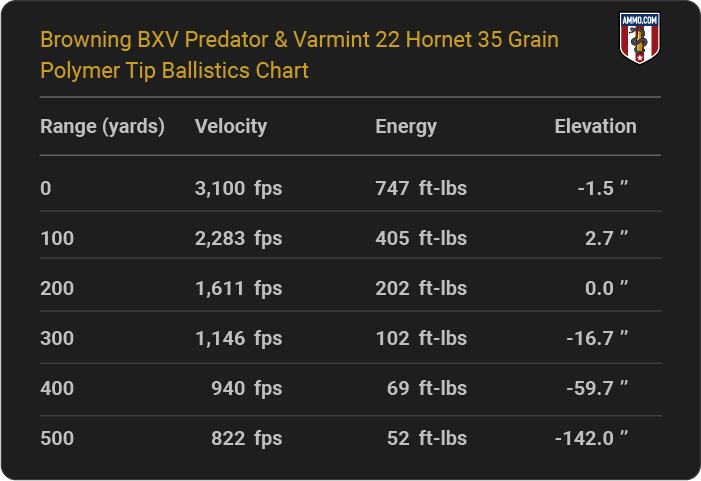
Federal Ammunition Ballistics - 22 Hornet
Federal Varmint & Predator 22 Hornet 35 grain Tipped Varmint Ballistics Chart

Hornady Ammunition Ballistics - 22 Hornet
Hornady Varmint Express 22 Hornet 35 grain V-MAX Ballistics Chart
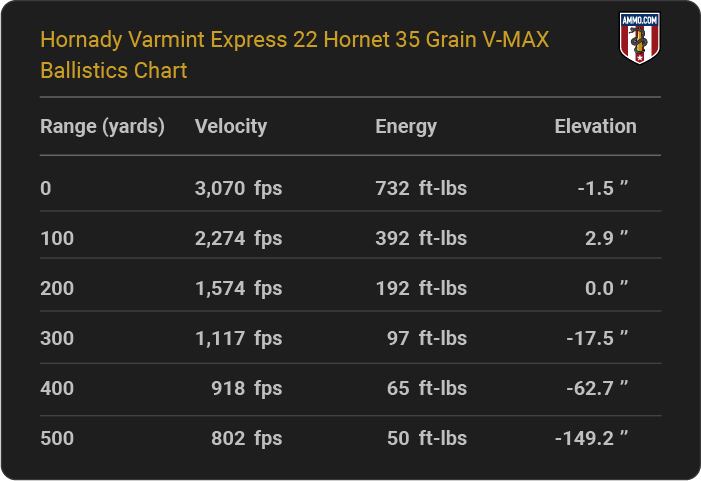
Nosler Ammunition Ballistics - 22 Hornet
Nosler Varmageddon 22 Hornet 35 grain FB Tipped Ballistics Chart
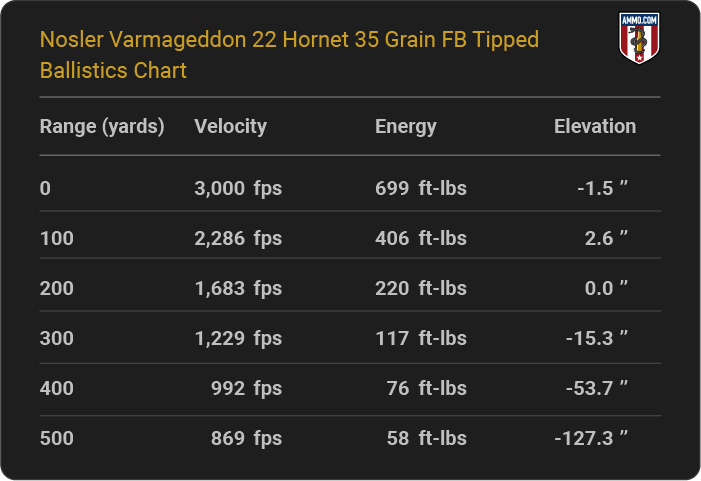
Prvi Partizan (PPU) Ammunition Ballistics - 22 Hornet
Prvi Partizan 22 Hornet 45 grain SP Ballistics Chart
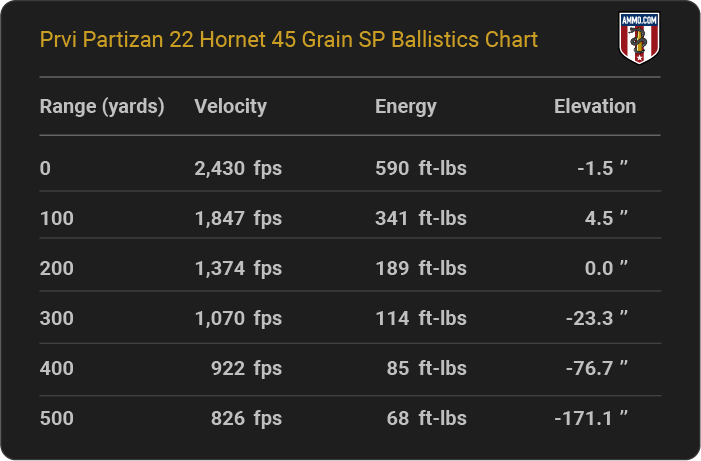
Remington Ammunition Ballistics - 22 Hornet
Jump to a ballistics chart: Remington High Performance 22 Hornet 45 grain PSP | Remington Premier AccuTip-V 22 Hornet 35 grain AccuTip-V
Remington High Performance 22 Hornet 45 grain PSP Ballistics Chart
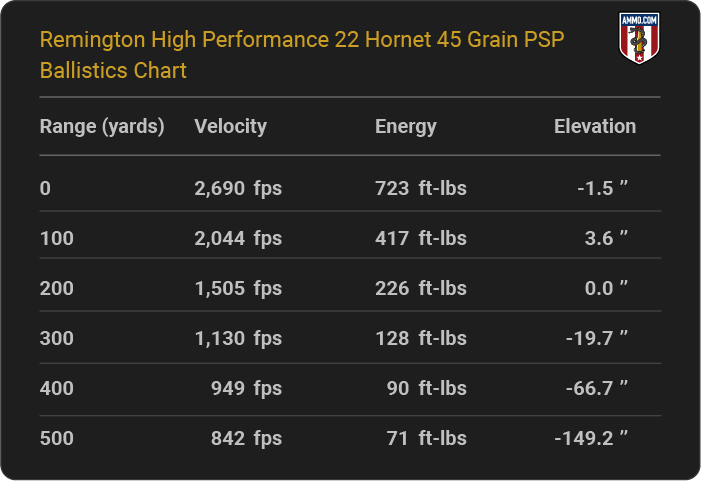
Remington Premier AccuTip-V 22 Hornet 35 grain AccuTip-V Ballistics Chart
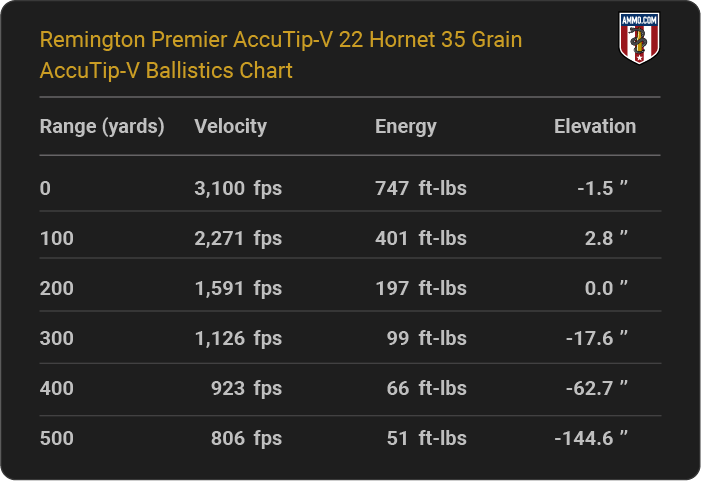
Sellier & Bellot Ammunition Ballistics - 22 Hornet
Jump to a ballistics chart: Sellier & Bellot 22 Hornet 45 grain FMJ | Sellier & Bellot 22 Hornet 45 grain SP
Sellier & Bellot 22 Hornet 45 grain FMJ Ballistics Chart
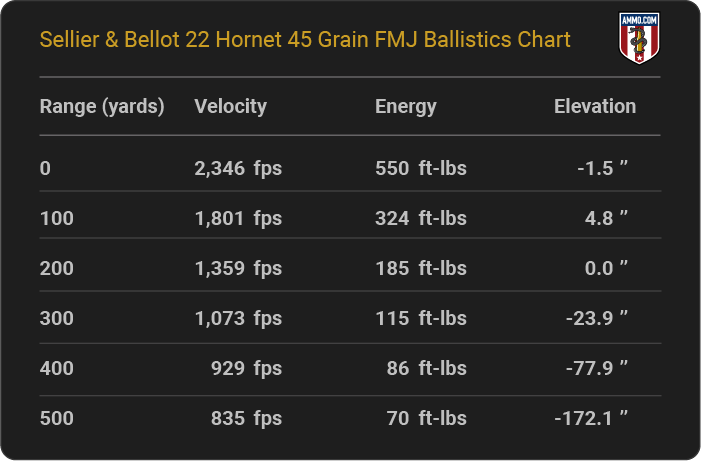
Sellier & Bellot 22 Hornet 45 grain SP Ballistics Chart
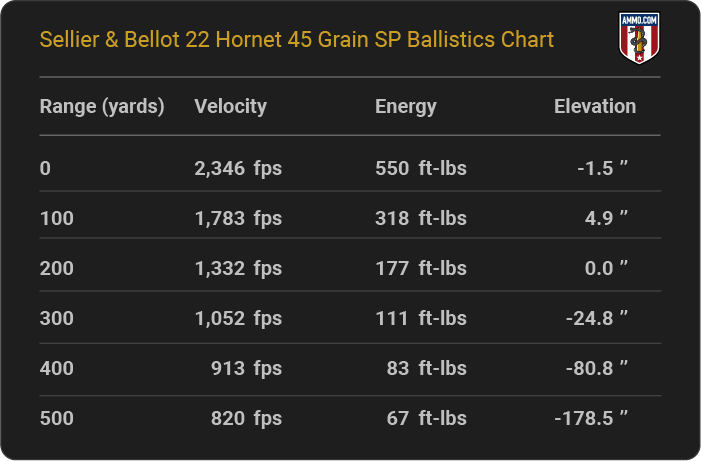
Winchester Ammunition Ballistics - 22 Hornet
Jump to a ballistics chart: Winchester Super-X 22 Hornet 45 grain JSP | Winchester Varmint X 22 Hornet 35 grain Polymer Tip Rapid Expansion
Winchester Super-X 22 Hornet 45 grain JSP Ballistics Chart
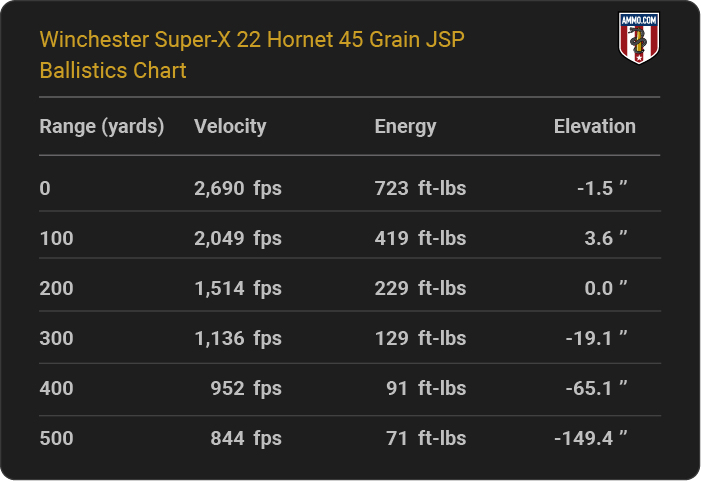
Winchester Varmint X 22 Hornet 35 grain Polymer Tip Rapid Expansion Ballistics Chart
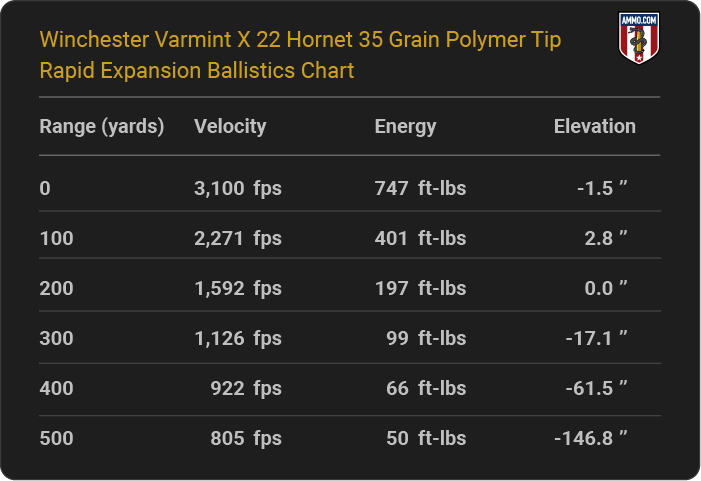
Administrative Note: The information above comes from the manufacturers. The actual ballistics obtained with your firearm can vary considerably from the advertised ballistics. Also, ballistics can vary from lot to lot with the same brand and type load. When manufacturer ballistic data were unavailable, ballistics were calculated using a ballistics calculator.
22 Hornet Trajectory Chart
A bullet’s flight path is also called its trajectory. Shooters often measure the bullet’s elevation in inches of bullet drop, but it’s also measured in minutes of angle (MOA).
Long-range shooters prefer a flat trajectory because it allows them to make fewer adjustments to compensate for bullet drop. The 6.5 Creedmoor and 22 ARC are both excellent examples of flat-trajectory cartridges, which contributes to their popularity among varmint hunters and long-range shooting enthusiasts alike.
The 22 Hornet's trajectory is reasonably flat out to 400 yards. After that point, it quickly runs out of steam and falls back to earth. When sighted in at 200 yards, a 22 Hornet cartridge with a 35 grain V-MAX bullet will drop -62.7 inches at 400 yards. By the time it reaches 500 yards, it will have dropped -149.2 inches. When zeroed in at the same range, the Remington High Performance round’s 45 grain PSP bullet will drop -66.7 inches at 400 yards and 149.2 inches at 500 yards.
Below is a sample 22 Hornet bullet drop chart that provides a general idea of 22 Hornet trajectory with a sight height of 1.5”.
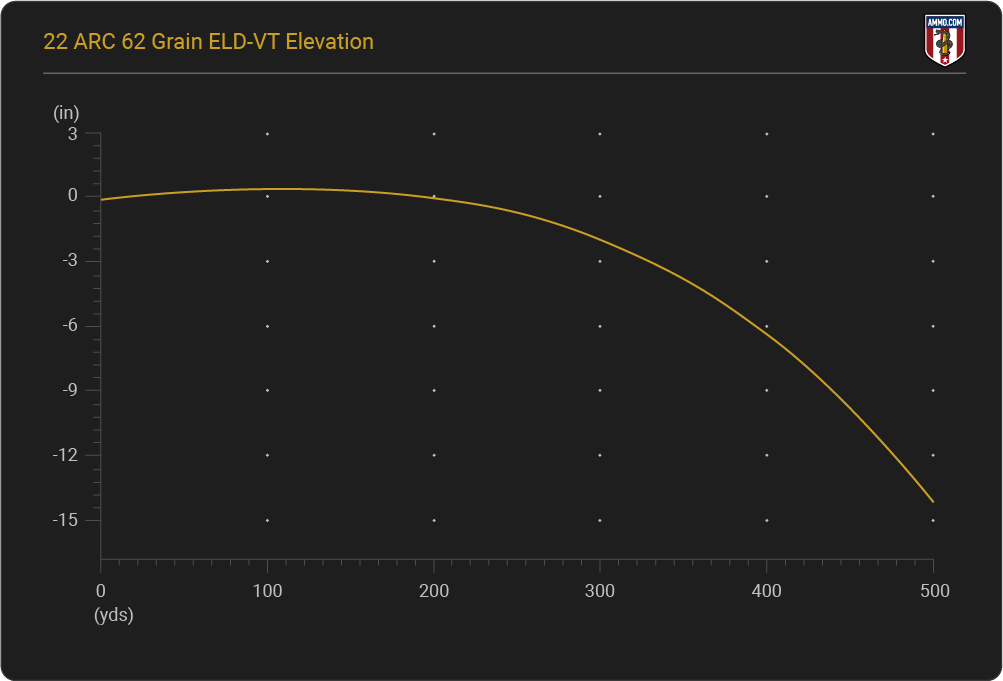
Note: The chart above is an example of one 22 Hornet load. Actual ballistic performance may vary depending on bullet weight, lot, barrel length, and environmental conditions while shooting.
22 Hornet Velocity
The rate at which a bullet exits the barrel is its muzzle velocity. American shooters measure velocity in feet per second (fps).
Generally, a longer barrel produces a higher muzzle velocity, as it gives the exploding propellant additional time to exert energy against the bullet’s base. Its design and weight also determine how much velocity a projectile will exhibit downrange.
Projectiles with a high ballistic coefficient, such as polymer-tipped hollow point boat tail bullets, tend to conserve velocity more efficiently than traditional soft point bullets. Heavier bullets have higher inertia and tend to exhibit relatively lower muzzle velocities as a result.
Handloads also tend to have higher velocities than factory ammo, which is one reason why reloading is so popular among competitive shooters.
The muzzle velocities of typical 22 Hornet loads range between 2,300 fps and 3,100 fps. The muzzle velocity you receive depends on the exact round you’re firing from your bolt-action rifle.
22 Hornet Kinetic Energy
American shooters measure a bullet’s energy in foot-pounds (ft-lbs). Muzzle energy reflects the force with which a projectile leaves the barrel. Heavier bullets tend to have higher muzzle energy. Velocity is also significant, which is why lighter bullets can have greater muzzle energy than heavier ones.
A higher muzzle energy typically indicates that the round has more recoil. The 22 Hornet’s lightweight bullets generate relatively little recoil energy. Although it is a centerfire cartridge with a reasonably large case capacity, the 22 Hornet’s relatively small bullet (which is comparable to that of the 22 Long Rifle – another popular round for single-shot survival rifles) grants it impressively low-recoil performance.
The biggest problem with lightweight projectiles is that they conserve relatively less energy downrange. The Winchester Varmint X 35 grain Polymer Tip has a muzzle energy of 747 ft-lbs – but by the time it reaches 500 yards, it only conserves 50 ft-lbs of kinetic energy. The 45 grain JSP is similar in that it has a muzzle energy of 723 ft-lbs and 71 ft-lbs of kinetic energy at 500 yards.
This means your Savage or Ruger 22 Hornet rifle is best suited for small game hunting, target shooting, and introducing a novice to shooting.
22 Hornet Effective Range
The 22 Hornet's low kinetic energy means its effective range is very limited. Two hundred fifty yards is conventionally regarded as the round’s limit for small game hunting.
When target shooting, you can stretch the 22 Hornet’s range out to 400 yards. Beyond that range, the round’s steep bullet drop presents a nearly insurmountable obstacle.
How Do 22 Hornet Ballistics Compare to Other Rifle & Handgun Cartridges?
Despite being a centerfire cartridge, the 22 Hornet is comparable to many rimfire cartridges like the 17 HMR, 22 LR, and 22 Winchester Magnum (WMR). At the same time, it’s fair to compare it to other centerfire cartridges such as the 218 Bee, 22 WCF, 222 Remington, 223 Remington, and the 22-K Hornet wildcat cartridge.
For convenience, the team at Ammo.com has compared the ballistics of a few of the calibers mentioned above.
22 Hornet vs. 22 Magnum Ballistics Chart

22 Hornet vs. 22 TCM Ballistics Chart
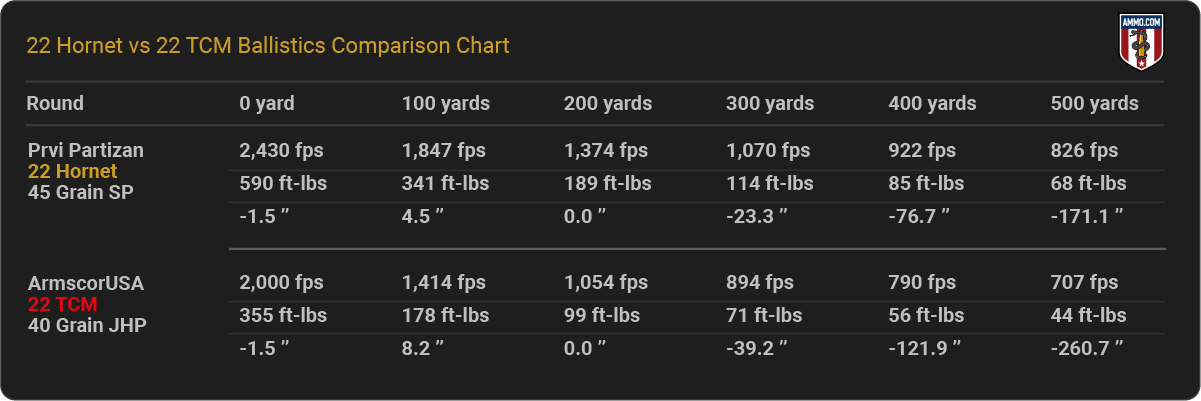
22 Hornet vs. 223 Ballistics Chart
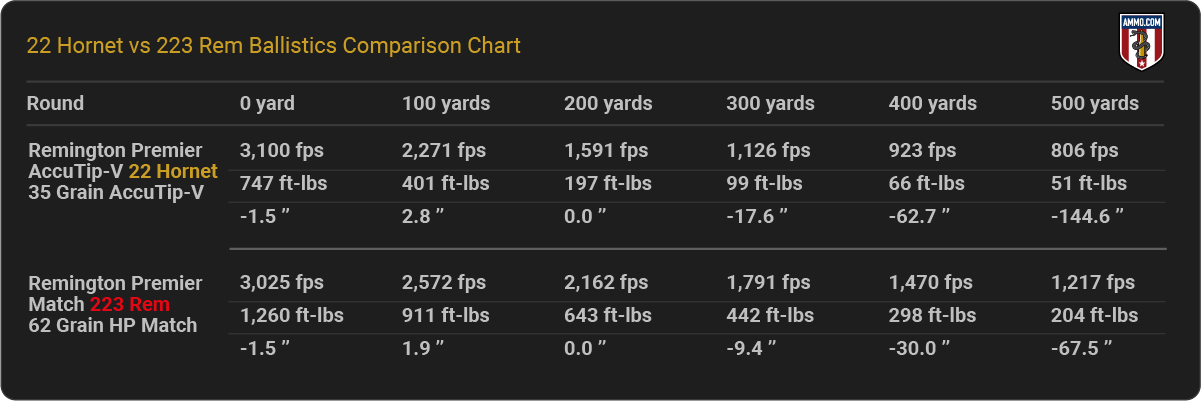
Don’t miss our in-depth comparison of the 22 Hornet vs. 223 Rem!
This article is an integral part of our expansive ballistics chart resources.
Frequently Asked Questions
The team at Ammo.com has gathered and answered the most commonly asked questions regarding 22 Hornet ballistics.
What is the difference between 22 Hornet and 223?
The difference between the 22 Hornet and 223 Rem is that the 223 Rem fires larger projectiles and can accurately shoot over 400 yards, unlike the 22 Hornet.
Should you use the .22 Hornet for small game and varmint hunting?
You should use the 22 Hornet for small game and varmint hunting within 300 yards. If you plan to fire over distances greater than 300 yards, consider another cartridge such as the 22-250 Rem or 22 ARC.
What is 22 Hornet comparable to?
The 22 Hornet is comparable to rifle cartridges such as the 222 Rem, 223 Rem, 22 WCF, 22 Creedmoor, 22-250 Rem, and 22 ARC.
How powerful is a 22 Hornet?
The 22 Hornet is more powerful than the 17 HMR, 22 LR, and 22 WMR – but less powerful than the 22-250 Rem or 22 ARC.
Ballistic Charts
- 308 Ballistics Charts
- 6mm ARC Ballistic Charts
- 10mm Auto Ballistics Charts
- 224 Valkyrie Ballistics Charts
- 204 Ruger Ballistics Charts
- 30-30 Ballistics Charts
- 6.8 SPC Ballistics Charts
- 350 Legend Ballistics Charts
- 300 Blackout Ballistics Charts
- FN 5.7x28 Ballistic Charts
- 7.62x39 Ballistics Charts
- 22 Creedmoor Ballistics Charts
- 300 PRC Ballistics Charts
- .360 Buckhammer Ballistics Charts
- 8.6 Blackout Ballistics Charts
- 30-06 Ballistics Charts
- 44 Magnum Ballistics Charts
- 7mm-08 Ballistics Charts
- 7mm Rem Mag Ballistics Charts
- 300 Win Mag Ballistics Charts
- 270 Win Ballistics Charts
- 45 Long Colt Ballistics Charts
- 6.5 Creedmoor Ballistics Charts
- 40 S&W Ballistics Charts
- 243 Win Ballistics Charts
- 357 Magnum Ballistics Charts
- 380 ACP Ballistics Charts
- 45 ACP Ballistics Charts
- 223 Rem Ballistics Charts
- 450 Bushmaster Ballistics Charts
- 400 Legend Ballistics Charts
- 5.56 Ballistics Charts
- 9mm Ballistics Charts
- 28 Nosler Ballistics Charts
- 45-70 Ballistics Charts
- 6.5 PRC Ballistics Charts
- 22-250 Ballistics Charts
- 22 Hornet Ballistics Charts
- 7mm PRC Ballistics Charts
- 22 ARC Ballistics Charts
- 6.8 Western Ballistics Charts
